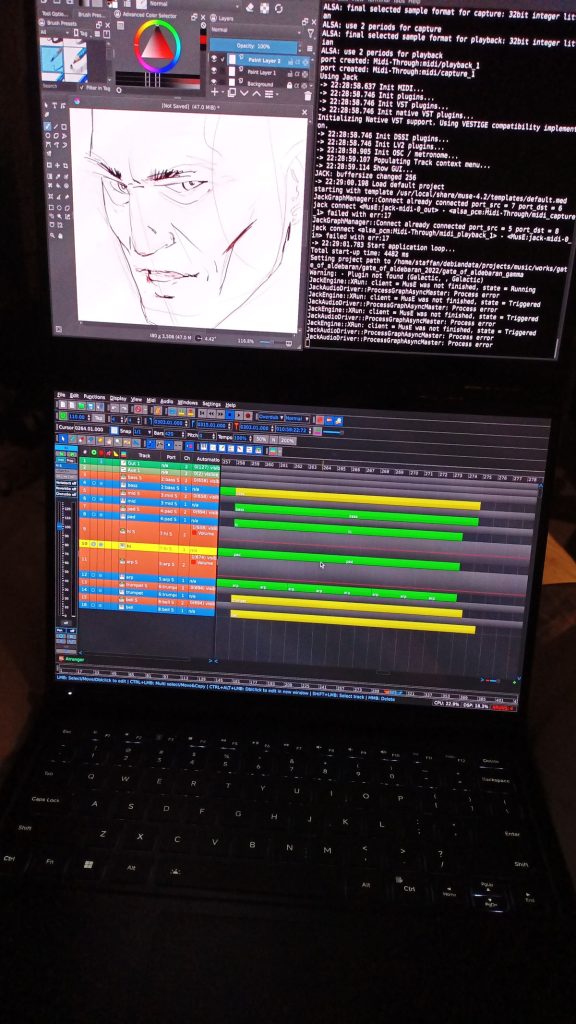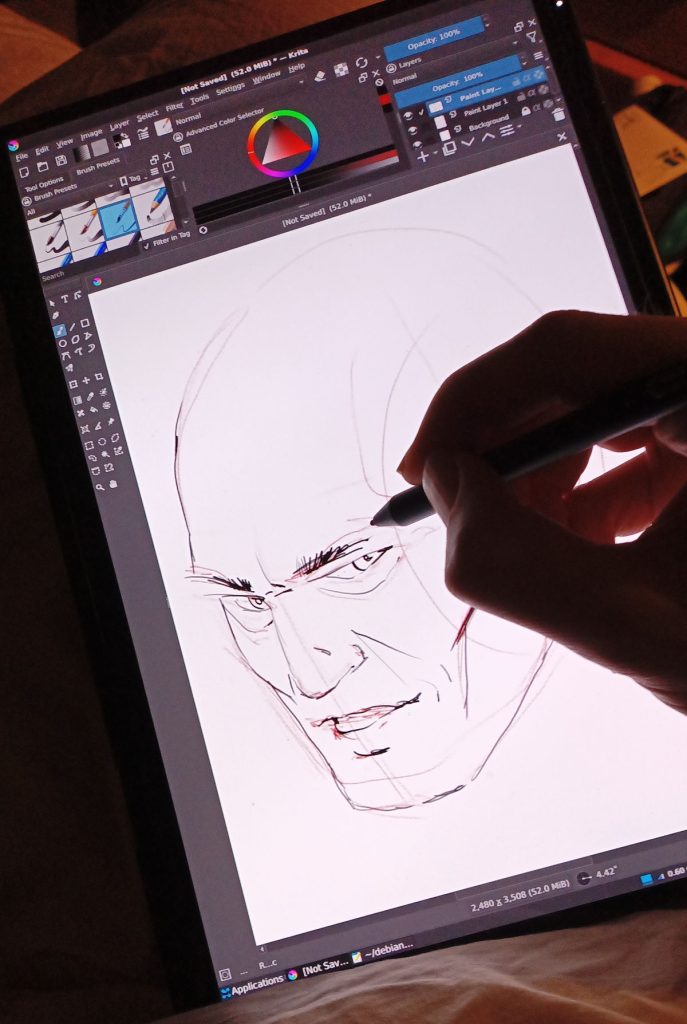This is a description on how to get Debian GNU/Linux with XFCE4 or KDE Plasma 6 on the GPD DUO. I have a GPD DUO AMD Ryzen™ AI 9 HX 370 with 64GB RAM and a 2TB SSD.
Setup Windows
I wanted to keep the Windows 11 Home installation, so I booted into it and cleaned it up a bit.
Next I downloaded the latest BIOS and installed it. It is version 2.18 at the time of writing (2.12 fixes the issue with the upper screen not turning on after suspend, 2.18 fixes the charging). There are instructions in the package, but you basically download an archive. unzip it, copy the files onto a USB stick, restart and press F7 to install the update.
I also updated the firmware for my 2TB SSD, I’ve read about people having trouble if not.
Finally I shrunk the D: (Windows data) drive to 200GB.
My partitioning scheme is as follows:
- 300 GB Windows 11 Home installation
- 200 GB Windows data
- 300 GB debian root
- 64 GB swap
- 500 GB debian data
- 500+ GB other future OS, eg Bazzite
Install Debian
I downloaded Debian 12 Testing (“trixie”) with non-free drivers. I used the weekly build for DVD.
Next I created a USB boot stick. Your USB stick must have UEFI boot enabled. Burn your ISO image to stick using eg Rufus. Open Rufus and under Partitioning Options select “GPT Partition Scheme for UEFI computer” (or something similar).
You can select the boot drive by pressing F7. Esc takes you to BIOS.
During installation I created a 300 GB debian root ext4 partition and a 64 GB swap partition.
With XFCE (on X)

I selected the XFCE4 desktop environment, to run with X11 (not Wayland).
This is what to do after installation and login.
Fix main screen. Go to Settings > Display, invert main screen and place it below the upper screen. Go to the Advanced tab and save the profile as “dual”. (This profile is used later.)
Make yourself “superuser” by typing su -, then nano /etc/sudoers, and add the line <myusernamn> ALL=(ALL) NOPASSWD:ALL. You can change this later.
Remove the USB stick from /etc/apt/sources.list if you have trouble running apt update, by running sudo nano /etc/apt/sources.list.
Install a firewall: sudo apt install ufw, then ufw enable.
Remove autostart items that you don’t want, Settings > Session and Startup.
Appearance
Things I did to customize XFCE4 to my liking (and for my eyesight).
Settings > Appearance. Select “Adwaita Dark” and set custom DPI: 192.
Settings > Desktop. Set desktop background to Transparent, ie a black background.
Settings > Windows Manager > Theme: Default x-hdpi.
Settings > Workspaces: 1. This is The DUO after all!
Panels. Right click a panel and enter Panel > Panel Preferences. Remove Panel 2. Select Panel 1, uncheck Lock and move it to the main screen, then reapply Lock. Row size: 40. Add any items you like.
Fix monitors, touch and stylus

Preparation
sudo apt install xinput
Use xinput --list to see all available input devices. Note how they change depending on if screens are on or off. Each device has a name and an id. Use xinput --list-props <device> to see what properties a device has. A device can be identified by name (in quotation marks), or by id.
You can list your screens by running xrandr -q. My screens are called DisplayPort-2 (upper) and eDP (main).
Create a directory somewhere in your home directory where all four scripts will go.
I made four scripts that setups the GPD DUO for: main screen only, both screens, upper screen only and upper screen only in tablet mode. The scripts works best if the “dual” display profile is applied before adjustments are made by the scripts. You can do this by going to Settings > Display > Advanced and apply the profile. But I have baked this into the scripts so you don’t have to.
To set this up, go to Settings > Display > Advanced and apply the “dual” profile. In the terminal, go to the directory where the scripts are (going to be) located and run: xfconf-query -c displays -p /ActiveProfile > profile.txt. This will save the id of the display profile in a text file that the scripts will use.
These scripts not only turn the screens on and off, but also rotates them, and it does them same with the two touchscreens and the stylus (and trackpad, for the tablet mode script). It also turns off touch input for screens that are not on.
Script for main screen only
Never turn off upper screen with Fn+F3. Use the scripts instead.
After running this script, all open windows might be moved to the lower border of the screen. Restore them by selecting them in the panel and press Super + Left/Right/Up/Down, or Alt + F10.
Save this script as gpd_duo_main.sh.
#!/bin/bash
# Re-apply saved Display Profile
MYDIR="$(dirname "$(readlink -f "$0")")"
profile="$(<$MYDIR/profile.txt)"
xfconf-query --create --type string -c displays -p /Schemes/Apply -s $profile
# Upper screen off
xrandr --output DisplayPort-2 --off
# Upper touch screen off
xinput disable "Jieli Technology USB Composite Device"
# Upper stylus off
xinput disable "Jieli Technology USB Composite Device Stylus stylus"
# Main screen on
xrandr --output eDP --auto
# Main touch screen on
xinput enable "GXTP7380:00 27C6:0113"
# Main stylus on
# xinput enable "GXTP7380:00 27C6:0113 Stylus"
xinput enable "GXTP7380:00 27C6:0113 Stylus stylus"
xinput enable "GXTP7380:00 27C6:0113 Stylus eraser"
# Main stylus
xinput set-prop "GXTP7380:00 27C6:0113 Stylus stylus" "Coordinate Transformation Matrix" -1 0 1 0 -1 1 0 0 1
xinput set-prop "GXTP7380:00 27C6:0113 Stylus eraser" "Coordinate Transformation Matrix" -1 0 1 0 -1 1 0 0 1
xinput set-button-map "GXTP7380:00 27C6:0113 Stylus stylus" 1 3 2 4 5 6 7
xinput set-button-map "Jieli Technology USB Composite Device Stylus stylus" 1 3 2 4 5 6 7
# Main touch
xinput set-prop "GXTP7380:00 27C6:0113" 'Coordinate Transformation Matrix' -1 0 1 0 -1 1 0 0 1
# Touchpad, CCWSP3105FT:00 0911:5288
# Reset
xinput set-prop "SP3105FT:00 0911:5288 Touchpad" "Coordinate Transformation Matrix" 1 0 0 0 1 0 0 0 1Script for both screens
Save this script as gpd_duo_both.sh.
#!/bin/bash
# Re-apply saved Display Profile
MYDIR="$(dirname "$(readlink -f "$0")")"
profile="$(<$MYDIR/profile.txt)"
xfconf-query --create --type string -c displays -p /Schemes/Apply -s $profile
# Upper screen on
xrandr --output DisplayPort-2 --auto
# Upper touch screen on
xinput enable "Jieli Technology USB Composite Device"
# Upper stylus on
xinput enable "Jieli Technology USB Composite Device Stylus stylus"
xinput enable "Jieli Technology USB Composite Device Stylus eraser"
# Main screen on
xrandr --output eDP --auto
# Main touch screen on
xinput enable "GXTP7380:00 27C6:0113"
# Main stylus on
xinput enable "GXTP7380:00 27C6:0113 Stylus stylus"
xinput enable "GXTP7380:00 27C6:0113 Stylus eraser"
# Upper touch screen, Jieli Technology USB Composite Device
# Y-axis is across both screens so scale
xinput set-prop "Jieli Technology USB Composite Device" "Coordinate Transformation Matrix" 1 0 0 0 0.5 0 0 0 1
# Upper screen stylus, Jieli Technology USB Composite Device Stylus
# Y-axis is across both screens, so scale
xinput set-prop "Jieli Technology USB Composite Device Stylus stylus" "Coordinate Transformation Matrix" 1 0 0 0 0.5 0 0 0 1
xinput set-prop "Jieli Technology USB Composite Device Stylus eraser" "Coordinate Transformation Matrix" 1 0 0 0 0.5 0 0 0 1
# Main touch screen, GXTP7380:00 27C6:0113
# The coordinates are inverted
xinput set-prop "GXTP7380:00 27C6:0113" 'Coordinate Transformation Matrix' 1 0 0 1 0 0 0 0 1
# And it is mapped to the upper screen, so map to lower screen
xinput map-to-output "GXTP7380:00 27C6:0113" eDP
# Main screen stylus GXTP7380:00 27C6:0113 Stylus
# Stylus coordinates on main screen are inverted and scaled to both screens
xinput set-prop "GXTP7380:00 27C6:0113 Stylus stylus" "Coordinate Transformation Matrix" -1 0 1 0 -0.5 1 0 0 1
xinput set-prop "GXTP7380:00 27C6:0113 Stylus eraser" "Coordinate Transformation Matrix" -1 0 1 0 -0.5 1 0 0 1
# Touchpad, CCWSP3105FT:00 0911:5288
# Reset
xinput set-prop "SP3105FT:00 0911:5288 Touchpad" "Coordinate Transformation Matrix" 1 0 0 0 1 0 0 0 1Script for upper screen only
Save this script as gpd_duo_upper.sh.
#!/bin/bash
# Re-apply saved Display Profile
MYDIR="$(dirname "$(readlink -f "$0")")"
profile="$(<$MYDIR/profile.txt)"
xfconf-query --create --type string -c displays -p /Schemes/Apply -s $profile
# Upper screen on
xrandr --output DisplayPort-2 --auto
# Upper touch screen on
xinput enable "Jieli Technology USB Composite Device"
# Upper stylus on
xinput enable "Jieli Technology USB Composite Device Stylus stylus"
xinput enable "Jieli Technology USB Composite Device Stylus eraser"
# Turn off main screen
xrandr --output eDP --off
# Main touch screen off
xinput disable "GXTP7380:00 27C6:0113"
# Main stylus off
xinput disable "GXTP7380:00 27C6:0113 Stylus stylus"
xinput disable "GXTP7380:00 27C6:0113 Stylus eraser"
# Upper touch screen, Jieli Technology USB Composite Device
# Reset
xinput set-prop "Jieli Technology USB Composite Device" "Coordinate Transformation Matrix" 1 0 0 0 1 0 0 0 1
# Upper screen stylus, Jieli Technology USB Composite Device Stylus
# Reset
xinput set-prop "Jieli Technology USB Composite Device Stylus stylus" "Coordinate Transformation Matrix" 1 0 0 0 1 0 0 0 1
xinput set-prop "Jieli Technology USB Composite Device Stylus eraser" "Coordinate Transformation Matrix" 1 0 0 0 1 0 0 0 1
# Touchpad, CCWSP3105FT:00 0911:5288
# Reset
xinput set-prop "SP3105FT:00 0911:5288 Touchpad" "Coordinate Transformation Matrix" 1 0 0 0 1 0 0 0 1Scripts for upper screen only, tablet mode
Save this script as gpd_duo_tablet.sh.
#!/bin/bash
# Re-apply saved Display Profile
MYDIR="$(dirname "$(readlink -f "$0")")"
profile="$(<$MYDIR/profile.txt)"
xfconf-query --create --type string -c displays -p /Schemes/Apply -s $profile
# Rotate left
# Upper screen on
xrandr --output DisplayPort-2 --auto --rotate left
# Upper touch screen on
xinput enable "Jieli Technology USB Composite Device"
# Upper stylus on
# xinput enable "Jieli Technology USB Composite Device Stylus"
xinput enable "Jieli Technology USB Composite Device Stylus stylus"
xinput enable "Jieli Technology USB Composite Device Stylus eraser"
# Turn off main screen
xrandr --output eDP --off
# Main touch screen off
xinput disable "GXTP7380:00 27C6:0113"
# Main stylus off
# xinput disable "GXTP7380:00 27C6:0113 Stylus"
xinput disable "GXTP7380:00 27C6:0113 Stylus stylus"
xinput disable "GXTP7380:00 27C6:0113 Stylus eraser"
# Upper touch screen, Jieli Technology USB Composite Device
xinput set-prop "Jieli Technology USB Composite Device" "Coordinate Transformation Matrix" 0 -1 1 1 0 0 0 0 1
# Upper screen stylus, Jieli Technology USB Composite Device Stylus
xinput set-prop "Jieli Technology USB Composite Device Stylus stylus" "Coordinate Transformation Matrix" 0 -1 1 1 0 0 0 0 1
xinput set-prop "Jieli Technology USB Composite Device Stylus eraser" "Coordinate Transformation Matrix" 0 -1 1 1 0 0 0 0 1
# Touchpad, CCWSP3105FT:00 0911:5288
xinput set-prop "SP3105FT:00 0911:5288 Touchpad" "Coordinate Transformation Matrix" 0 -1 1 1 0 0 0 0 1Last
Make all scripts executable, chmod +x *.sh.
Bind the scripts to shortcuts, Settings > Keyboard > Application Shortcuts. I bound them like this:
- Script – Main screen only: Super + 1
- Script – Both screens: Super + 2
- Script – Upper screen only: Super + 3
- Script – Upper screen only, tablet mode: Super + 4
Stylus buttons
I have a MPP stylus, a GPD stylus that I bought for my GPD Pocket 3. It has two buttons on the side. They seem to map to left and middle mouse buttons. But I want the upper to map to right click. Run xinput list to get the id of the main screen stylus (for me it is GXTP7380:00 27C6:0113 Stylus Pen (0) id=19).
Run xinput set-button-map 19 1 3 2 4 5 6 7 to reorder the buttons. Note that you have to do it for the upper screen too (id 18 in my case).
Fixes and tips
Tip: Move windows between screens
Settings > Windows Manager > Keyboard. Set Shift + Super + Up/Down to Move window to lower monitor/to upper monitor.
Tip: Make window cover both screens
Create a shortcut to make the active window cover (most of) both screens. sudo apt install xdotool. Go to Settings > Keyboard > Application Shortcuts.
Add the following command bash -c "xdotool windowsize $(xdotool getwindowfocus) 2870 3500 && xdotool getactivewindow windowmove 0 0" to Super + F.
Add bash -c "xdotool windowsize $(xdotool getwindowfocus) 2000 1000 && xdotool getactivewindow windowmove 0 0" to Shift + Super + F to restore.
Fix: Touchpad stops working
Lost ability to use touchpad? Try one of these three things:
The following lines fixes this issue. Put them into a script and bind them to a key combination:
!/bin/bash
sudo modprobe -r i2c_hid_acpi
sleep 0.5
sudo modprobe i2c_hid_acpiOr switch to a terminal using the keyboard. Type sudo systemctl suspend and let the Duo go to sleep. Then wake it up again.
Ctrl + Alt + F1 to go to a TTY, then Ctrl + Alt + F7 to go back. This worked before for me, but not any longer.
Fix: Firefox (and maybe other programs) hangs
Fix 1. Symptom: OS works fine. Then you suspend, and a couple of minutes later Firefox hangs. When this happens, recover the GPU helps temporarily: sudo cat /sys/kernel/debug/dri/0/amdgpu_gpu_recover.
A more permanent solution is to disable PSR and PSR-SU by editing grub:sudo nano /etc/default/grub and add amdgpu.dcdebugmask=0x210 to the line: GRUB_CMDLINE_LINUX_DEFAULT="quiet amdgpu.dcdebugmask=0x210". Remember to sudo update-grub afterwards.
Fix 2. Use Settings > Keyboard > Application Shortcuts to map sudo cat /sys/kernel/debug/dri/0/amdgpu_gpu_recover to Ctrl + Alt + R.
Fix: Firefox touch control
Fix touch input (zoom and scrolling) in Firefox by adding the lineMOZ_USE_XINPUT2 DEFAULT=0 OVERRIDE=1
to the file /etc/security/pam_env.conf. Log in and out.
Fix: VS Code
The right click menu in VS Code stops working if the compositor is off. Enable the compositor, Settings > Window Manager Tweaks > Compositor. Turn off vblank_mode as this might cause problems:xfconf-query -c xfwm4 -p /general/vblank_mode -t string -s "off" --create
Tip: Disable Power Manager
As I had problems with the upper screen on BIOS < 2.12, I decided to disable the Power Managers handling of the screen. I don’t know if this solves anythin, really. Power Manager > Display: Display power management: off
Tip: Better brightness adjustment of main screen
Right click Battery icon > Properties. Set Brightness Steps: 20, check Exponential.
Tip: Control brightness of upper screen
Shortcuts and slider under Battery only affects Main screen, use hardware buttons for upper screen. Or install
sudo apt install ddcutilThen run
sudo ddcutil detectIt will show that you have a display on /dev/i2c-17 named “SGT – Stargate Technology”. This is the upper screen. If you run
sudo ddcutil probeit will show a list of all features. We are interested in “Feature: 10 (Brightness)”. Confirm this:
sudo ddcutil vcpinfo 10Get current brightness value:
sudo ddcutil getvcp 10VCP code 0x10 (Brightness ): current value = 4, max value = 100
Set brightness (0-100):
sudo ddcutil setvcp 10 <value>Tip: Hibernate and Suspend activation
Enter Suspend by right clicking the Action button in the Panel. Enter suspend by typing
sudo systemctl hibernateas the Hibernate accessible from the Action button doesn’t seem to work.
Tip: Disable fluidsynth autostart
For some reason fluidsynth is started at boot/login.
sudo systemctl --global disable fluidsynth.serviceShortcuts
After following this guide you can control both screens, and windows, by using shortcuts. Move windows between screens, make them smaller, tile them etc, using a combination of shortcuts added in this guide and those that come with XFCE4:
- Applications menu Alt + F1-F3
- Tile to left: Super + Left
- Tile to right: Super + Right
- Tile to top: Super + Up
- Tile to bottom: Super + Down
- Terminal: Ctrl + Alt + T
- File Manager: Ctrl + Alt + F (add)
- Web browser Ctrl + Alt + W (add)
- Text editor: Ctrl + Alt + E (add)
- Window to upper screen: Shift + Super + Up
- Window to lower screen: Shift + Super + Down
- Maximize over both screens (if not Fullscreen): Super + F
- Make window smaller again: Super + Shift + F
- Fullscreen: F11
- Maximize window: Alt + F11 (same to reverse)
- Full window: Alt + F10
- Thunar context menu: Fn + Right Ctrl (menu key)
- Script – Main screen only: Super + 1
- Script – Both screens: Super + 2
- Script – Upper screen only: Super + 3
- Script – Upper screen only, tablet mode: Super + 4
KDE Plasma
I selected the “KDE Plasma” desktop environment (for Wayland).
I let the installation finish and rebooted.
After rebooting I had to remove my USB stick from /etc/apt/sources.list.
I logged in using the KDE Plasma (Wayland) session.
In System Settings > Display Configuration:
- Built-in Screen: Orientation: Upside Down
- I placed the top screen “Stargate Technology 16” above the “Laptop” screen
In System Settings > Touch Screen you must map the right touchscreen to the right display:
- Device: Jieli*, Enabled, Target display: DP*
- Device: GXTP*, Enabled, Target display: eDP-1*
Now touchscreens and pen works!.
Tip: Moving between screens
Bring window from screen A to screen B: Use Meta + Shift + Right and Meta + Shift + Left.
More useful shortcuts can be found here: System Settings > Keyboard > Shortcuts, Application: KWin, search for “Window to”.
Fix: Graphic artifacts
Some random graphic artifacts appear sometimes. Also, bringing media in Firefox to fullscreen hangs the UI.
To fix this (temporarily) set Color Profile to Built in in the Display Configuration (https://bbs.archlinux.org/viewtopic.php?id=298355).
TBD: Rotate grub
I have this in my /etc/default/grub:
GRUB_CMDLINE_LINUX_DEFAULT="video=eDP-1:panel_orientation=upside_down i2c_touchscreen_props=GXTP7380:touchscreen-inverted-x:touchscreen-inverted-y"And it rotates after a while, but…
TBD: Login screen
Touch screen is inverted on login screen. So to bring up the on screen keyboard press on the opposite corner.
Final words
If you have any questions and/or suggestions, contact me, and I will try to answer/fix things.
